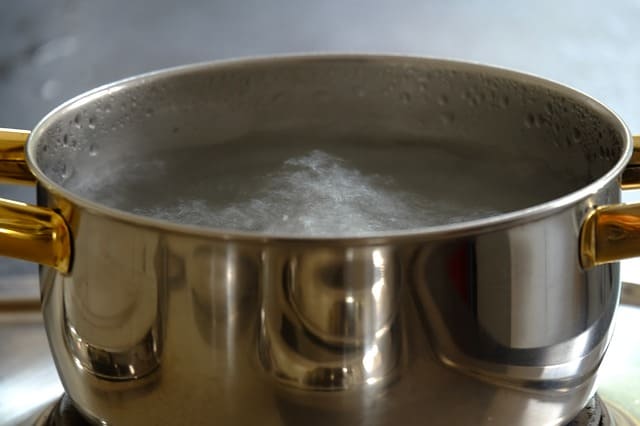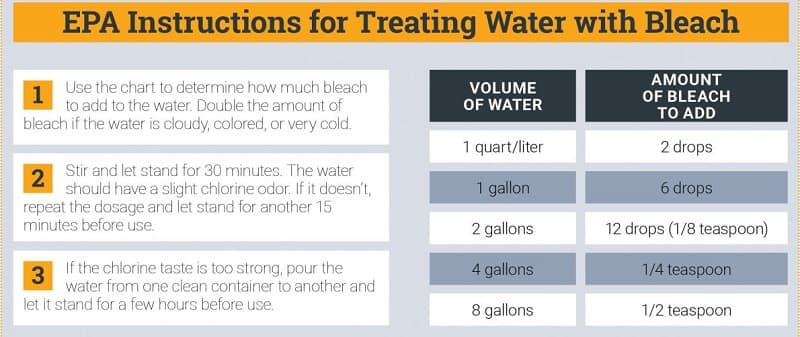Hopefully, you pay attention to the news and have alerts set up on your emergency radio because boil advisories are very common.
During a boil alert, the water may be unsafe to drink and must be treated. Other water treatment methods can be used during a boil alert, but filtering will not be effective.
Here’s why.
What Is a Boil Advisory?

Also called a boil alert, a boil advisory is issued whenever there may be contaminants in the tap water. These contaminants may include:
- Bacteria
- Protozoa
- Viruses
Boiling water for at least 1 minute will kill these contaminants.
To properly boil water during an alert, you should heat the water until you see bubbles coming to the surface. This is known as a “rolling boil.” Start counting your 1 minute from when the water is at a rolling boil.
Note: If you live above 6,561 feet, you’ll need to boil the water for at least 3 minutes. This is because water boils at a lower temperature at high altitudes.
Why Are Boil Advisories Issued?
There are four main reasons that boil alerts are issued. Depending on the reason for the boil alert, different contaminants might be present.
- Water Main Breaks: When a water main breaks, contaminants from the soil around the pipe can enter the pipes.
- Power Outages: The water treatment plant may stop working during large-scale power outages. If your power goes out, don’t use tap water until you’ve checked whether a boil alert is in place!
- Sewage Leaks: When sewage pipes leak and get into the water distribution system, there is a considerable risk of viral, bacterial, and other pathogenic contaminants.
- Pressure Loss: Pressure loss in the water system can allow contaminants to enter the pipes.
- Natural Disasters: Especially during flooding, the water treatment center cannot handle all the water. Untreated water gets into the distribution system. The water could contain contaminants because sewage mains overflow or break during disasters (such as earthquakes).
Why Water Filters Aren’t Adequate During Boil Advisories
A good water filter (I’m not talking about your standard kitchen filter) will have a micron rating of 0.2 or less. These water filters are very effective at removing bacteria and protozoa.
Water filters will NOT remove viruses, though!
During some boil alerts, such as those caused by water main breaks, there is little risk of viral contamination. In theory, a good water filter could make the water safe to drink. However, the water department rarely tells us why the boil alert was issued. Always assume the worst and treat the water for viruses, too.
Depending on where you live, there might be a significant risk of viruses in your water. One EPA study examined drinking water from 14 communities that don’t treat the water with chlorine or UV light. They found that 24% of water samples contained viruses!
Boil Alerts and Chemical Spills
One time you won’t hear a boil alert is after a chemical spill or other type of chemical contamination. Boiling will not remove chemicals from water. Boiling makes the threat worse because evaporation concentrates the chemicals.
If a chemical spill occurs, your city will tell residents only to drink bottled water. These alerts are usually called “Do Not Drink” or “Do Not Use” alerts. This happens quite frequently, such as the 2016 chemical spill in Corpus Christi and the 2017 chemical runoff in Airway Heights.
The takeaway point? Always have bottled water in addition to a way to boil water!
Recommended: How To Store Water For Emergencies
Water Safety during a Boil Advisory
Use Only Boiled Water for:
- Drinking and cooking
- Infant formula
- Pets’ water
- Brushing teeth
- Washing produce
- Making coffee (most coffee makers don’t get hot enough to purify the water)
Showering during a Boil Advisory:
You can safely shower with tap water during a boil advisory. However, young children should be carefully supervised to ensure they don’t swallow any water. Give them sponge baths to reduce risk until the boil alert is lifted.
Washing Dishes during a Boil Advisory:
If your dishwasher has a “hot-Sani” setting, it can be used to wash dishes during the boil alert. Otherwise, you must sanitize your dishes after washing them with tap water.
To sanitize your dishes,
- Mix 1oz (6 teaspoons) of unscented bleach with 3 gallons of lukewarm water.
- Soak dishes in this solution for 1 minute.
- Let air dry.
What If the Tap Water is Yellow or Cloudy?
So long as you’ve boiled the water, even yellow or cloud water will be safe to drink.
Note that the water can still have a nasty taste to it. Add a pinch of salt and let it sit before drinking to get rid of the bad taste. Or, add lemon juice or powdered drinks to mask the bad taste.
Alternatives to Boiling Water
If you cannot boil water to treat it, there are other options.
1. Bleach
Unscented bleach is very effective and perfectly safe for treating water. It will kill bacteria, most parasites, and viruses. You can find detailed instructions on how to treat water with bleach here.
Note that bleach doesn’t kill all parasites, including Cryptosporidium. However, camping water filters will remove parasites, so you can filter the water and then use bleach to kill viruses.

2. Water Purification Tablets or Drops
These are great to add to your disaster supplies. They are small, last a long time, and very easy to use.
3. UV Water Treatment
UV water treatment systems look like pens that you stick into the water. They shoot out UV rays, which scramble the DNA of bacteria, protozoa, and viruses.
They are highly effective, though there is some debate about how long the effect lasts. If you wait too long to consume the water, the DNA could “unscramble” and cause the pathogens to become active again.
I’m not the biggest fan of UV water treatment systems for disaster prep because they rely on batteries and are expensive.
4. Sawyer Point Zero Two Water Filter
NOTE: This filter is temporarily unavailable.
Generally, no water filter will make water safe during a boil advisory. Even the best camping water filters won’t remove viruses. However, there is one exception.
The “Point Zero Two” water filter made by Sawyer filters down to 0.02 microns (hence the name). This is small enough to filter out even viruses.
The water filter is fairly pricey but has a faucet adapter and lasts a lifetime.
Key Disaster Preparedness Takeaways:
- Have an emergency stove for boiling water (read about options here).
- Keep unscented bleach in with your disaster supplies.
- Stockpile bottled water
- Get an emergency radio so you can stay informed about boil alerts.




With the comment about using bleach, I heard that if you have to use bleach and water for sanitizing, you would mix 8oz of bleach to a gallon of water. Only problem is this, do you add 8 oz to a gallon of water or 8 oz to 100 oz of water.
Hello Herbert, the recommended EPA guidelines are given in the post. See image above. Or check out this post on purifying water with bleach.
There is one method guaranteed to fix any water contamination problem without the need for chemicals or fancy filters/purifiers and that is distillation. You can make your own that uses the power of the sun or build one from a food caner/pressure cooker, a length of high temperature tubing and a coil of copper tubing. Discard the first cup to eliminate chemicals with lower vapor temperatures than water and you’re good to go.
in the article there is an error. Bleach doesn’t kill parasites. crypto is one of the number 1 causes for a boil advisory. in the article it mentions that bleach is a good alternative to making water safe.
Good catch. Thanks. Bleach only kills *most* pathogens in water – not crypto. We are updating the post now.
Testing on the Black Berkey shows that the system removes greater than 99.9% of viruses. It’s unhelpful to make unverified claims such as the Point Zero 2 is the only exception to the rule that filters won’t remove viruses. Sounds to me like you’re trying to sell the Point Zero 2. Which is fine as long as you stick to the truth.
If you read the comment again you will understand that nobody is claiming the Point Zero 2 as the only exception. Simply that it is one of the newer more specialized filters available that will remove viruses.
Of course there are other filters on the market that will do the same and more are being added all the time as the technology improves.
Not true, “Purifiers” WILL purify contaminated water. Both virus, bacteria, and chemical contamination can be done.
Whatever purifier you choose, you need to pre-filter to at least “clear water” (sediment, debris, etc) filter to prolong the use of your purifier.
Start wit gathering water from clear, odor free as possible sources. Then it is recommended (CDC) if the water is of unknown quality that you add 8-10 drops plain bleach. Let stand at least one hour before running through your purifier.
I use Berkey black filters in my stainless filter system. They are rated for 3000 gallons, depending on the level of contaminants. Pre-filtering with say… bio-sand units will clean the water up quite well.
One other thing. Bleach can drop in effectiveness given time and evaporation. Storing liquid bleach in large quantities is not recommended. Given that the dry form of bleach used in pools is contaminated with other chemicals, as far as I’ve found, makes this too not recommended. There is hope though. MSR (Mountain Safety Research) has a devision devoted to water purification. They have developed a small, powerful (provides enough bleach generation) enough to provide sanitation for entire villages. The power source is 12 volts and can be supplied from a moped battery, common in many villages.
Hope this helps…
Purifier is a pretty generic term which can be used with many different methods of removing contaminants from water. As far as filters go, most of these (aside from some newer, specialized filters like the Sawyer Point Zero Two mentioned) will not remove viruses. Activated carbon filters may get out chemicals, but they aren’t as effective on bacteria.
The bottom line? No water purification method is perfect for all scenarios. You may need to combine purification methods to ensure water is safe to drink.